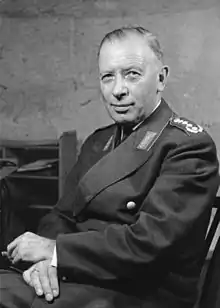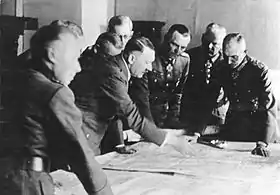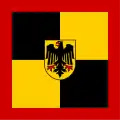Adolf Heusinger
Adolf Bruno Heinrich Ernst Heusinger (4 August 1897 – 30 November 1982) was a German military officer, whose career spanned the German Empire, the Weimar Republic, Nazi Germany and West Germany. Heusinger joined the German Army as a volunteer in 1915 and later became a professional soldier. He served as the commander in chief of the general staff of the High Command of the German Army in the Nazi German Armed Forces from 1937 to 1944, consequently being appointed chief of general staff for 2 weeks in 1944 after his predecessor (Kurt Zeitzler) abandoned his post due to a nervous breakdown. He was then appointed head of the military cartography office when the war ended. He later became a general for West Germany and served as head of the West German military from 1957 to 1961 as well as Chairman of the NATO Military Committee from 1961 to 1964.
Adolf Heusinger | |
|---|---|
 Heusinger in Bundeswehr uniform, c. 1960 | |
| Chairman of the NATO Military Committee | |
| In office December 1961 – 1 April 1964 | |
| Preceded by | Charles Paul de Cumont |
| Succeeded by | Charles Paul de Cumont |
| Inspector General of the Bundeswehr | |
| In office 1 June 1957 – 31 March 1961 | |
| Preceded by | Office established |
| Succeeded by | Friedrich Foertsch |
| Chief of the OKH General Staff | |
Acting | |
| In office 10 June 1944 – 21 July 1944 | |
| Preceded by | Kurt Zeitzler |
| Succeeded by | Heinz Guderian |
| Personal details | |
| Born | 4 August 1897 Holzminden, Duchy of Brunswick, German Empire |
| Died | 30 November 1982 (aged 85) Cologne, North Rhine-Westphalia, West Germany |
| Spouse(s) | Gerda Luise Krüger (m. 1931) |
| Children | 2 |
| Military service | |
| Allegiance | |
| Branch/service | |
| Years of service | 1915–1945 1955–1964 |
| Rank | Generalleutnant (Wehrmacht) General (Bundeswehr) |
| Battles/wars | World War I World War II |
| Awards | Wound Badge of 20 July 1944 in silver |
Biography
Early career
Heusinger was born in Holzminden, in the Duchy of Brunswick, German Empire. He entered the Prussian Army in 1915, becoming an officer in 1917. Following the war, Heusinger was retained in the Reichswehr of the Weimar Republic. In 1931, Heusinger was assigned to the operations staff of the Troop Office (Truppenamt) in the Ministry of the Reichswehr, the German Army's covert General Staff in circumvention of the Treaty of Versailles, which forbade that institution. In August 1937, Heusinger was assigned to the Operations Staff of the re-established Army General Staff of Wehrmacht. He served there, being promoted to lieutenant colonel on 20 March 1939, and remained in that position until 15 October 1940, when he became its chief.
World War II

With the outbreak of the Second World War, the German Army High Command (the OKH) assumed its wartime organization. Heusinger accompanied the field staff and assisted in the planning of operations for the invasions of Poland, Denmark, Norway, and France and the Low Countries. He was promoted to colonel on 1 August 1940, and became chief of the Operationsabteilung in October 1940, making him number three in the Army planning hierarchy, after the Chief of the General Staff, General Franz Halder, and the Deputy Chief of the General Staff/Chief Quartermaster, General Friedrich Paulus.
After the invasion of the Soviet Union in June 1941, the OKH became primarily responsible for planning operations in that theatre, while the Armed Forces High Command (Oberkommando der Wehrmacht, or OKW) was responsible for other theatres. Halder was replaced as Chief of the General Staff in September 1942 by General Kurt Zeitzler. Heusinger remained chief of the Operationsabteilung and was promoted to Generalleutnant on 1 January 1943. In June 1944, Zeitzler suffered a nervous breakdown and abandoned his post, and on 10 June, Heusinger temporarily assumed his office as Chief of the General Staff of the Army. In this capacity, he attended the meeting at Adolf Hitler's Wolf's Lair on 20 July 1944, and was standing next to Hitler when the bomb planted by Claus von Stauffenberg exploded.
Heusinger was hospitalized for his injuries in the explosion, but afterwards was arrested and interrogated by the Gestapo to determine his role, if any, in the July Plot. Although there was evidence that Heusinger had had contacts with many of the conspirators, as had all other high-ranking Nazi military leaders, there was no evidence to connect him to the plot and he was released in October 1944. According to Heusinger's own autobiography, he has published an essay ("Denkschrift") which Hitler himself received very positively and in which he publicly revealed all information he had on the conspirators that plotted against the Führer. He reaffirmed that he has not participated in the assassination plot as he still felt an obligation to fulfil his duty as a soldier of the German Reich despite his personal view that the war had already been lost.[1] After his release he was placed into the Führerreserve - a reserve army of high-ranking Nazi military leaders awaiting assignments - and was not assigned to another position until 25 March 1945, when he was made chief of armed forces mapping department (Chef Wehrmacht-Kartenwesen). He was later taken prisoner by the Western Allies in May 1945.
Post-World War II
An internee from 1945 to 1947, Heusinger testified during the Nuremberg Trials.
In 1950, he became an advisor on military matters to Konrad Adenauer, the first Chancellor of West Germany. He served in the Blank Office Amt Blank, the office headed by Theodor Blank, which became the West German Ministry of Defense in 1955.

With the establishment of the West Germany Armed Forces Bundeswehr in 1955, Heusinger returned to military service. He was appointed a Generalleutnant (lieutenant general) on 12 November 1955,[2] in the Bundeswehr and chairman of the Military Leadership Council (Militärischer Führungsrat).
In March 1957, he succeeded Hans Speidel as chief of the Bundeswehr's all-armed forces department (Chef der Abteilung Gesamtstreitkräfte).

Shortly thereafter, in June 1957, Heusinger was promoted to full general and named the first Inspector General of the Bundeswehr (Generalinspekteur der Bundeswehr), and served in that capacity until March 1961. In April 1961, he was appointed Chairman of the NATO Military Committee in Washington, D.C., where he served until 1964 when he retired. He was, according to news reports, wanted by the Soviet Union in the early 1960s for war crimes committed in the occupied Soviet territories. [3]
Heusinger died in Cologne on 30 November 1982, aged 85.
According to documents released by the German Federal Intelligence Service in 2014, Heusinger may have been part of the Schnez-Truppe, a secret army that veterans of the Wehrmacht and Waffen-SS sought to establish in the early '50s.[4]
References
- A. Heusinger: Befehl im Widerstreit, Schicksalsstunden der deutschen Armee 1923–1945. Tübingen und Stuttgart 1950, S. 362.
- This was actually a promotion from his Wehrmacht rank of Generalleutnant. Until 1945, the German Army general officer ranks of Generalmajor (major-general) and Generalleutnant (lieutenant-general) were equivalent to one-star (brigadier or brigadier general) and two-star (major general) ranks, respectively. The Bundeswehr uses a NATO-standardized rank structure, with the addition of the one-star rank of Brigadegeneral and Generalleutnant the equivalent to three-star rank in the British and American armies.
- KEYSTONE news Agency
- Wiegrefe, Klaus, "Files Uncovered: Nazi veterans Created Illegal Army", Spiegel Online, 14 May 2014
Further reading
- Searle, Alaric (2003). Wehrmacht Generals, West German Society, and the Debate on Rearmament, 1949–1959. Westport, CT: Praeger Publishers. ISBN 978-0-275-97968-3.
External links
- Biography on BMVg website
- http://www.dhm.de/lemo/html/biografien/HeusingerAdolf/
- Adolf Heusinger - CIA: CIA's file on Heusinger, released under the Nazi War Crimes Disclosure Act. The document shows that Heusinger initialled the Commissar Order and Commando Order, but, due to his cooperative attitude, no further action was taken.
| Military offices | ||
|---|---|---|
| New title | Chief of Staff of the Federal Armed Forces 1 June 1957–31 March 1961 |
Succeeded by General Friedrich Foertsch |
| Preceded by C.P. de Cumont |
Chairman of the NATO Military Committee 1963–1964 |
Succeeded by C.P. de Cumont |

